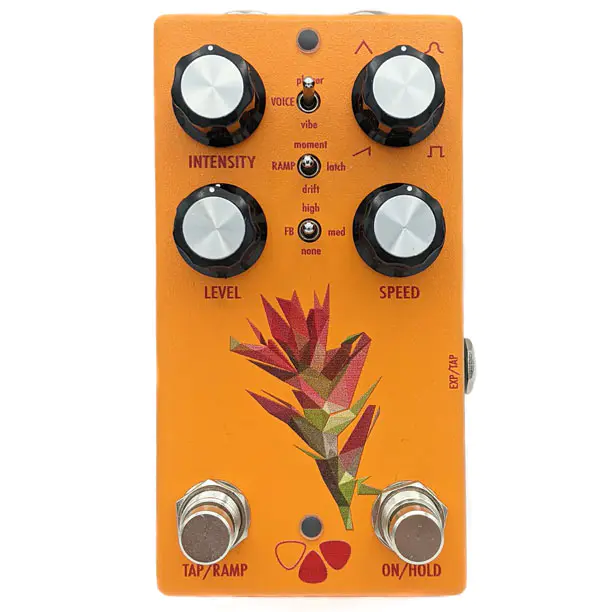
Those looking for a boutique multi-modulation pedal with tons of flexibility should check out the Castilleja by Flower Pedals, a device that packs a ton of tone within a compact case.
It’s a 4 stage analog optical phaser with digital controls and two voicings, selectable through the top toggle:
- a standard 4 stage Phaser (Phase 90-style)
- a classic Univibe.
And with the right settings, it can also cover Vibrato and Chorus duties.
But that’s just the beginning: the top left knob offers 4 LFO Waves (Sine, Square, Sawtooth and Triangle), while another toggle switch delivers 3 Levels of Feedback (none, low, and high) and an option to switch between chorus (50/50 wet and dry) and vibrato (mostly wet) modes.
A third toggles switch configures the Tap/Ramp Footswitch:
- Momentary ramping mode ramps the LFO’s speed to a secondary speed for as long as you press it.
- Latch ramping, ramps to the secondary LFO speed and stays there until you press the footswitch again.
- Drift mode takes your base speed and then modulates that speed up and down to a different LFO, while allowing you to use tap tempo to set your main speed. The speed and depth of these modes are controlled via holding the On/Hold footswitch and adjusting the Speed and Shape knobs.
The Flower Pedals Castilleja also has an Exp input that can be set to accept external Tap Tempo.
Hear how it sounds in the videos below.
Looking for lush modulation to wash your tones across a prairie at sunset? Take a listen to the Castilleja Phaser! It’s a 4 stage analog optical phaser with digital controls. Unlike most phasers, this one has 2 different voicings: the first a standard 4 stage phaser in the vein of classics such as the Phase 90, and the second voiced like the classic Univibe.
In addition to the two classic voicings, the Castilleja also has 3 levels of feedback (none, low, and high) as well as an option to switch between chorus (50/50 wet and dry) and vibrato (mostly wet) modes. Four continuously variable waveforms are selected via the Shape Knob. The frequency and depth of the LFO are controlled by the Speed and Intensity knobs. The Level controls the overall output volume with plenty of boost on tap.
Want more than just one simple LFO speed to work with? Then you’re in luck! The Castilleja features 3 different speed ramping modes in addition to tap tempo with 4 different subdivisions. The first mode is Momentary ramping, in which you hold the Tap/Ramp footswitch to ramp to a secondary speed, then release to ramp back to the main speed. The second mode is Latch ramping, where you just tap the Tap/Ramp footswitch to ramp to a secondary speed. Tap again to ramp back to the first speed. Last, but not least, is the Drift mode. This mode takes your base speed and then modulates that speed up and down to a different LFO. In Drift mode you can also use tap tempo to set your main speed. The speed and depth of these modes are controlled via holding the On/Hold footswitch and adjusting the Speed and Shape knobs.
A couple of little extra features are also available. One is the Exp/Tap jack, which allows you to either use an external tap connection to control tap and ramp or an expression pedal (signal tip) to control the speed. When an expression pedal is plugged in, you can set the heel and toe speeds using the Speed knob and the secondary function of the Speed knob. An internal switch allows you to choose between expression and tap. Note: DO NOT plug in a TS cable for tap if you have the switch in expression mode, as it could damage the pedal. You can also choose whether the pedal defaults to on or off on power up by holding the On footswitch while plugging in power.
So let some prairie fire spread across your tone garden!
The Castilleja operates on 9V center negative, with less than 100 mA.























